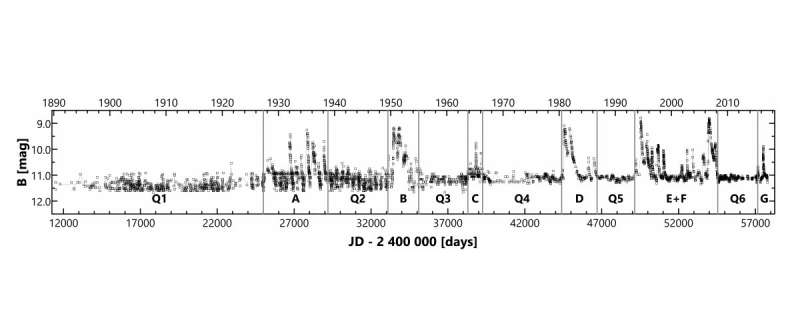The historical light curve (LC) of AG Dra over the period 1889 - 2017, constructed on the basis of the photographic and the B band observations. The LC is divided into active (A - G) and quiescence (Q1 - Q6) stages by vertical lines. The thin curve shows spline fit to the data points. Credit: Šafárik et al., 2017.
European astronomers have spotted an unusual outburst activity of a binary star system known as AG Draconis. New observations reveal that the recent changes of brightness of this star are slightly different than the changes that occurred during previous outbursts. The findings were presented October 13 in a paper published on arXiv.org.
Located in a spherical halo around the Milky Way, AG Draconis (AG Dra for short) is a classical symbiotic variable binary of type S. The system consists of a cool red giant with an effective temperature of about 4,300 K and a hot white dwarf with a high temperature of at least 100,000 K. The red giant is about 30 times larger than our sun, however, it has a mass of only 1.5 solar masses. The system's white dwarf is about 40 to 60 percent less massive than the sun. The stars fully orbit each other approximately every 550 days.
AG Dra is one of the most studied symbiotic star systems as its variations in brightness have been observed by astronomers for more than a century. The binary experiences a characteristic symbiotic activity with the alternation of active and quiescent stages. Its apparent magnitude of around 9.8 is known to increase by up to 1.4 when outbursts occur during active stages that take place at intervals of nine to fifteen years.
Previous observations of AG Dra have shown that these active stages consist of several outbursts repeating at about a one-year interval. The observed periods of activity start with a major outburst that is usually cool as the expanding pseudo-atmosphere of the white dwarf cools down. However, the latest phase of activity, which started with an outburst in 2015, appears to be different from previous ones.
A team of astronomers led by Jaroslav Merc of the Pavol Jozef Šafárik University in Košice, Slovakia, has analyzed the recent activity of AG Dra using data from the Astronomical Ring for Access to Spectroscopy (ARAS) database. They found that the brightness of AG Dra started to increase in the first half of 2015, with a weak pre-outburst. The second and more prominent outburst occurred in April 2016.
The study revealed that in May 2015 the brightness of AG Dra began to rise, achieving 10.7 mag in B and 9.6 mag in the V filter. The researchers described the event as a less prominent, minor outburst. During the second outburst that took place in April 2016, the binary reached maximum brightness of 9.9 and 9.1 mag in the B and V filters, respectively.
Given that both brightenings were classified as minor (hot) outbursts, the recent period of activity of AG Dra seems unusual when compared to previous ones.
"According to the photometric behavior, both brightenings belong to the minor outbursts of AG Dra. Such photometric behavior of the active stage is very untypical because more often, the activity of AG Dra starts with the major outburst," the paper reads.
The astronomers noted that active periods of AG Dra usually commence with major outbursts when the brightness reaches 8.8 and 8.4 mag in the B and V filters, respectively. The newly observed unusual activity raises questions about the nature of these outbursts. The authors assume that the events could belong to a new type of outbursts or they could indicate some transition between the hot and cool outbursts.
More information: arxiv.org/pdf/1710.04831.pdf
© 2017 Phys.org
























